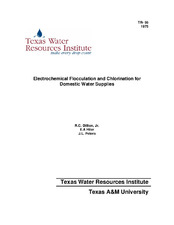| dc.description.abstract | Three electrochemical chlorinators were developed, tested and evaluated. The first used natural chlorides in the water to produce a chlorine residual; the second and third produced chlorine residuals by electrolysis of brine solution. Brine feed rate of the second chlorinator was controlled by a metering pump; this control in the third chlorinator was by the electro-osmotic flow through a cation exchange membrane.
Two electrochemical flocculators were developed, tested and evaluated. The first used a low current density, a long polarity reversal period and low purity aluminum alloy electrodes, so that the scale which formed on the plates was loosely attached. The second flocculator eliminated scaling of the plates by using a high current density, shorter polarity reversal period and higher purity aluminum alloy electrodes.
The low current density flocculator and the low-chloride chlorinator were field tested on surface pond water. The high current density flocculator, electro-osmotic chlorinator and incline tube settler were also field tested. The operating costs of the two systems for treating surface pond water were $1.13 per 1000 gal and 92.7¢ per 1000 gal, respectively. Both systems were capable of removing color and turbidity along with reducing other chemical elements such as iron, calcium and silica. | en |


